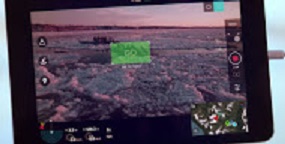
Movidius, the leader in low-power computer vision, and DJI are bringing new levels of autonomy to DJI aircraft through a sophisticated vision-aided flight system.
The technology debuted in DJI’s flagship Phantom 4 aircraft, giving it the ability to sense and avoid obstacles in real time and hover in a fixed position without the need for a GPS signal.
The agreement marks an industry first in making advanced visual guidance systems a standard feature for consumer drones. Such systems are expected to enable a broad range of new industrial and recreational applications that were not possible before.
DJI, the world’s leading maker of drones and aerial cameras, has developed specialized software algorithms in spatial computing and 3D depth sensing. These algorithms coupled with the Movidius' Myriad 2 VPU gives the DJI Phantom 4 drone the ability to sense and avoid obstacles in real time, meaning more autonomous flight functions, and improved awareness of flight space while in the air. Other visual intelligence features include improved vision-based tracking modes and advanced mapping capabilities.

“DJI continuously works to make complex technology accessible for anyone with a creative vision. As a result, we constantly seek ways to expand our technological capabilities to push the industry beyond what is thought possible,” said Paul Pan, Senior Product Manager at DJI. “Movidius’ vision processor platform, Myriad 2, met the rigorous requirements we set for our flagship product, and we look forward to continued collaboration with Movidius as we push the boundaries in the drone market.”
DJI’s vision algorithms were designed from the ground-up for real-time aerial autonomy. The performance-to-power ratio advantage of the Myriad 2 VPU — MA2100 matched DJI’s algorithm closer than any other traditional processor solutions.
“DJI has set the direction for the future of the drone market and we are excited to incorporate Movidius’ low power artificial vision intelligence technology into DJI drones moving forward,” said Sean Mitchell, COO of Movidius. “Moving the technology from a demonstration to a highly reliable production worthy stage was a tremendous effort for both DJI and Movidius. The DJI Phantom 4 launch represents a milestone for the future of visually aware devices. We believe we are entering the golden age of embedded computer vision and our technology has placed Movidius at the forefront of this trend.”
About DJI
DJI is a global leader in developing and manufacturing innovative drone and camera technology for commercial and recreational use. DJI’s global operations currently span North America, Europe and Asia, and its revolutionary products and solutions have been chosen by customers in over 100 countries; for applications in film, advertising, construction, fire fighting, farming, and many other industries.
About Movidius
Movidius is the leader in high performance, ultra-low power computer vision technology for connected devices. By marrying sophisticated software algorithms to a powerful, purpose-built Vision Processing Unit (VPU), Movidius brings new levels of visual intelligence to smart devices. Movidius’ dedicated machine vision solutions enable a new wave of intelligent and contextually aware devices including drones and AR/VR devices. With offices in Silicon Valley, Ireland, Romania and China, Movidius is a venture-backed company with investors including Atlantic Bridge Capital, Draper Esprit, Robert Bosch Venture Capital, and Summit Bridge Capital.
Additional Background Information
- DJI commands roughly half the drone market globally
- Movidius Myriad 2 Vision Processing Unit (VPU) will be the #1 visual intelligence system for drones by shipping volume based on sales projections (can we estimate a number?)
- DJI represents the second major Movidius customer this quarter using Myriad 2 for advanced artificial vision applications (first being Google).
- DJI wanted to go big with the Phantom 4 and reached out to Movidius with some ambitious ideas.
- Vision applications like Sense & Avoid, Active Track have been shown in tech demos before, but very, very hard to implement reliably at production level.
DJI Built a “visual cortex” to power the Phantom 4
- DJI wanted to go big with the Phantom 4 and reached out to Movidius with some ambitious ideas.
- Vision applications like Sense & Avoid, Active Track have been shown in tech demos before, but very, very hard to implement reliably at production level.
- Movidius provided the Myriad 2 processing platform with 12 customizable vision cores for DJI to create features never before seen on a commercially available drone.
- Myriad 2 provided the processing environment that allowed DJI not to run just 1 of their newest computer vision algorithms, but 4,5,6 all at once in real time, based on 5 simultaneous camera inputs.
- DJI + Movidius took what was previously in R&D labs and brought the product readiness in less than 12 months.
The Chip Behind the Phantom 4’s New AI Flight Functions
- DJI’s new Phantom 4 sets a new bar in terms of autonomous flight features and ease of use.
- In order to accomplish this, DJI developed some extremely advanced computer vision algorithms to do things like recognize objects, and map its surroundings in 3D.
- In order to crunch all this new data at high speeds necessary for real-time flight, and without impacting size or weight, DJI selected the Myriad 2 Vision Processor from Movidius.
- Myriad 2 is not like a CPU that you see in a standard PC. It is a processor designed from the ground up to handle vision-based tasks, similar to the way our human brain has a dedicated visual subsystem.
- This dedicated visual system gave DJI the flexibility to run multiple computer vision algorithms in parallel, giving Phantom 4 amazing new levels of intelligence.
- With these types of processors now available in drones, we expect to see more advanced AI functions in drones.
Advertisement
Learn more about Electronic Products Magazine





